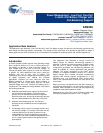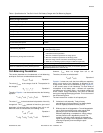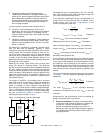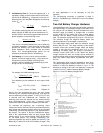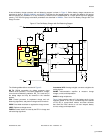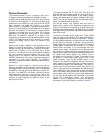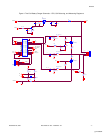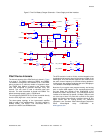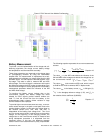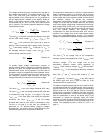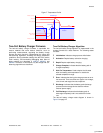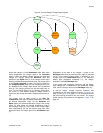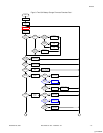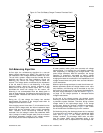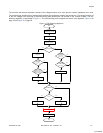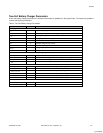
AN2309
November 25, 2007 Document No. 001-17394 Rev. *B - 4 -
Cell Balancing Time: If C is the cell capacity and
b
V
is
the battery voltage, and the requirement is to eliminate
the amount of imbalance (in percent) in one hour of
balancing time, then the power dissipation on balancing
circuit
P
bal
is:
100%
b
CV
P
bal
Equation 10
For example, balancing the cells for one hour with a
battery capacity of 2000 mAh and an imbalance of 15
percent results in the following approximate amount of
power dissipation on the balancing circuit:
2000 4.2 15%
1.26
100%
mAh V
PW
bal
Equation 11
Thus, there is a tradeoff between the rate of balancing
and power dissipation. Faster balancing provides more
options and flexibility, but it also results in increased
power dissipation, which increases cost and board
space. The one charge/discharge period can be
selected as a favorable time for cell balancing.
Cell Capacity: If n is the count of cells connected in
parallel, C is the cell capacity, and is the amount of
imbalance in percent (capacity and charge level
variation), then the highest required balancing current
during one hour is the following:
100%
Cn
I
bal
Equation 12
For example, the initial balancing level is:
2000 2 15%
600
100%
mAh
I mA
bal
Equation 13
If the balancing circuit resistance is set to equal 100Ω,
then:
4.2 /100 42I V mA
bal
Equation 14
4.2 0.042 0.1764P V A W
Equation 15
Using a four hour discharge time and a two hour charge
time during one complete discharge/charge cycle with full
time cell balancing on both phases, 42 mA*(4+2)=252 mA
is removed from one unbalanced cell. Therefore, the
balancing level from this example can be removed during
three discharge/charge cycles with a balancing circuit
resistance of 100Ω or during one complete cycle with 40Ω.
For maximum cell balancing, use a balancing circuit
resistance of 40Ω to 200Ω and perform cell balancing during
both charge and discharge phases. Note that the overnight
conditioning cell-balancing algorithm is not implemented in
this project. The reason is that the CY8C24xxxA device
used in this implementation does not have enough ROM
memory space. If you choose another PSoC device family
for the same project, the overnight conditioning cell-
balancing algorithm can easily be added (see AN2258, “Cell
Balancing in a Multi-Cell Li-Ion/Li-Pol Battery Charger”). But
for most applications it is not necessary to use this
algorithm.
The cell-balancing technique is explained in detail in
AN2258, “Cell Balancing in a Multi-Cell Li-Ion/Li-Pol Battery
Charger.”
Two-Cell Battery Charger Hardware
Li-based batteries use a two-stage charge profile (activation
and rapid-charge). If the battery voltage is less than 2.9 to
3.0 volts per cell, the battery must be activated first. In the
activation stage, the battery is charged with a constant
current (0.05-0.15 CA, where CA is the nominal battery
capacity) until the battery voltage reaches a predefined
level. The activation charge time-out is set to 1.5 to 2 hours.
The activation charge can diagnose battery health and
identify troubles such as damaged or shorted cells.
The rapid-charge stage starts after the activation charge
finishes without error. This stage consists of two modes:
constant current and constant voltage. When the battery
voltage is less than the predefined level (4.1V or 4.2V
depending on battery type), the charge is processed in
constant current mode (0.5-1.0 CA). When the battery
voltage reaches this level, the charge source switches to
constant voltage mode and the charge process is terminated
when the current drops below a predefined limit (0.07-
0.2 CA).
The rapid-charge stage must be protected by time limits.
The rapid-charge time is limited to three hours. The charge
profile for Li-Ion/Li-Pol batteries is shown in Figure 2. The
technique to charge Li-Ion and Li-Pol batteries is explained
in detail in AN2107 “A Multi-Chemistry Battery Charger.”
Figure 2. Li-Ion/Li-Pol Battery Charge Profile
Legend:
I
ch
- Battery charge current
I
act
- Battery activation charge current, 0.1-0.2 CA
I
rap
- Battery rapid charge current, 0.7-1 CA
V
b
- Battery voltage
V
rs
- Rapid start voltage, typically 3 V/cell
- Constant-current / constant voltage switching point
V
max
- Emergency shutdown voltage, 4.3 V/cell
- Rapid charge termination current, typically 0.1 CA
T
rmax
- Battery rapid charge maximum temperature, 45
o
С
T
rmin
- Battery rapid charge minimum temperature, 0
o
C
T
b
- Battery temperature
t
rch
- Rapid charge termination time
t
cv
- Constant voltage charge time
1
2
3
4
5
6
7
8
[+] Feedback



